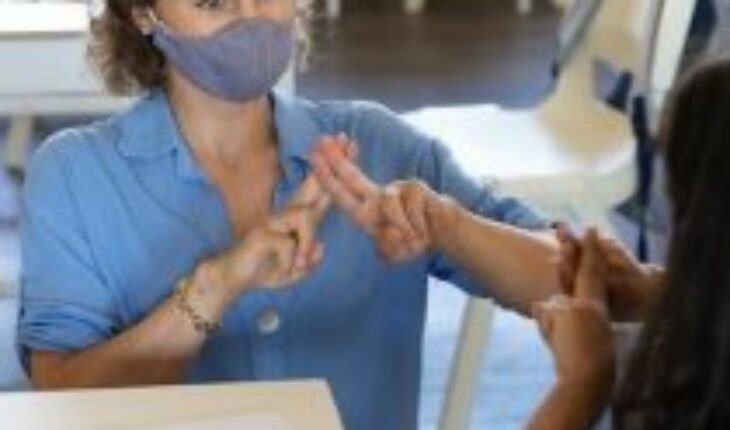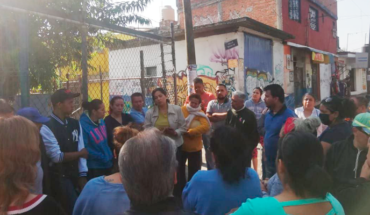Masks were unusual before the covid-19 pandemic. We saw them, for example, during visits to the operating room and the dentist. Although its use evoked in most a certain uneasiness about the nature of these occasions, this was not comparable to the deep concern they provoked in people who depend on lip reading to communicate.
At the beginning of the pandemic, the use of masks became universal in countries such as Spain. Since then, aware of the usefulness of masks to reduce the spread of the coronavirus, most of us normalize their use. However, we forget the impact that not being able to see the lips has on the 430 million deaf and hard of hearing people in the world.
Masks have increased the barriers deaf people encounter during face-to-face communication. They have also hindered access to information in other media such as audiovisual.
We recently published a study involving almost 400 deaf people from both Spain and the United Kingdom. We found that 76% of deaf people felt they had lost large amounts of vital information due to masks. In addition, 56% said they felt disconnected from society.
This study was a team effort of deaf and hearing researchers that emphasized accessibility. The survey questions were presented in two written languages and three sign languages: Spanish, British and Catalan. Presenting the questions in their preferred language helped to ensure that more deaf people were represented in the results.
This becomes evident, for example, if we think about my case. Despite having been working in English-speaking countries for 15 years, you are more likely to participate in a survey in Spanish but refuse to answer the same questions in English, as answering in the non-preferred language is always more expensive. The same would happen with many deaf signatories, who would systematically not be represented in non-accessible research.
The deaf population is not all the same
The second benefit the study showed was the emphasis on capturing the variability inherent in deafness. The deaf population is not a homogeneous group, there are many factors that can affect the communicative strategies of people with deafness.
The level of deafness is decisive because the smaller the auditory rest, the more likely it is that the person depends on purely visual information to communicate. At the same time, the distortion of sound caused by the mask will impact more people with mild or moderate deafness than those with profound deafness.
The age of onset of deafness also has important repercussions. In the case of hearing loss due to age, most tend to want to hide their deafness and reduce the number of interactions. Deaf people from an early age often learn to use all kinds of visual information to communicate better. This includes lip reading but also gestures and, in the best cases, sign language.
The third important factor is whether the deaf person is a signatory or not. Sign language uses easy expression and lip movements but does not depend exclusively on them. If the person belongs to a group of signers, they are likely to have different communication strategies.
Finally, the individual ability to read lips correctly would also influence the impact of the mask. Usually deaf people are better than hearing people in lip reading, but within this there is a lot of variability. For deaf people who do not get as much out of lip movements under normal conditions, the mask would be less disruptive than for those who tend to read lips fluently.
A man wearing a transparent mask asks for help using sign language.
Shutterstock / oscardimalva
Loss of information during the pandemic
The aforementioned study revealed that:
People whose deafness started late said more information had been lost. People with early deafness have developed effective communication mechanisms other than lip reading throughout their lives. When lip reading became impossible, they already had other strategies.
All deaf people reported poorer quality of life and feelings of disconnection from society. These negative effects were strongest in the deaf signatories.
In a time of Uncertainty, communication barriers due to masks, as well as the lack of sign language information in society in general, made the feeling of disconnection with society more evident.
All participants agreed that masks with a clear window around the lips facilitated communication, from grocery shopping to a hospital visit. Deaf signers valued fully transparent masks better because they allowed them to see the whole expression.
Visual communication (signs, gestures and even writing) was positively valued to reduce communication barriers due to the use of masks.
Figure 1. Example of communication barriers due to the use of masks in audiovisual media. Without being able to read lips and without subtitles, it was impossible for most deaf people to access information in the news.
Author provided
In a situation of communicative difficulty the best thing we can do is keep trying by all means we can think of. Sometimes it seems that the message is not so relevant, insisting on making yourself understood seems like a lot of effort for little benefit. However, we must understand that the benefits of not breaking communication go far beyond conveying the concrete message. Continuing communication can have positive effects on feelings of connection with other human beings and on the psychological well-being of interlocutors.
The authors of the study hope that these data will be taken into account to develop policies for future health emergencies. Deaf people are not a homogeneous whole. On the contrary, there are different needs that must be understood and taken into account. Also during a pandemic.
Article translated thanks to the collaboration with the Lilly Foundation.
Eva Gutierrez-Sigut, Lecturer in Psychology, University of Essex
This article was originally published on The Conversation. Read the original.
Follow us on





